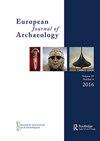Editorial
IF 1.4
2区 历史学
0 ARCHAEOLOGY
引用次数: 0
Abstract
In ten days, I’ll be on a plane to Europe to join many of you at the EAA annual conference in person for the first time since we met in Bern in 2019. I’ve missed seeing so many friends and colleagues in person, but I also know that the accessibility of hybrid conferences to lower income and disabled archaeologists as well as those with caring responsibilities is not something we want to lose. There is also the environmental impact of people like me flying around the world for a conference, and that is no small thing. If there’s one lesson to learn from the past two years (and there are, of course, many more than one), it’s that just because something has always been done in a given way, that’s not necessarily the only or the best way. As we face the effects of climate change head on, flexibility, community support, and the power to imagine and work towards a better world are some of our strongest virtues. In this issue of the European Journal of Archaeology we feature six articles and five book reviews. The articles this issue have a strong prehistoric focus but also include an important quantitative analysis of early medieval dietary changes and the reviews are extremely diverse, ranging from Bronze Age metallurgy to analytical methods. These include two further reviews in our special ‘Reviewing the Classics’ section. Januszek and colleagues start this issue with a topic near and dear to my heart: third millennium BC lithic technology. They apply a variety of macroscopic and microscopic analyses to 24 ground flint arrowheads from Suprasĺ 3 in north-eastern Poland to explore the unique chaîne opératoire and the significance of these pieces. This analysis is further nuanced as the arrowheads themselves are from ritual contexts. They connect these arrowheads to innovative practices by people on the periphery of the Bell Beaker world. This sort of creative reinterpretation is increasingly recognized as a special feature of communities in margins or frontier zones, and the arrowheads presented here neatly support the model. Instead of identifying a new type of grave, Brück and Booth return to a very wellstudied assemblage of British Bronze Age burials with new methods to ask: what if these burials don’t represent a single moment in time? Building on a major radiocarbon dating campaign as well as histological and contextual analysis, they argue that some individuals seem to have been buried one or more generations after death. This implies a period during which human remains circulated in the community, perhaps remaining somewhat ‘alive’ in a social sense; and it further calls into question our attempts to understand individual identity through the analysis of grave goods. Schaefer-Di Maida also offers a re-evaluation of a known type of Bronze Age site, in this case the so-called ‘cooking stone pits’ from northern Europe. These pits of fire-cracked stones vary in size, shape, layout, and age. A function in food preparation or European Journal of Archaeology 25 (4) 2022, 417–418社论
十天后,我将乘坐飞机前往欧洲,与大家一起参加EAA年会,这是自2019年我们在伯尔尼会面以来的第一次。我错过了见到这么多朋友和同事的机会,但我也知道,我们不想失去低收入和残疾考古学家以及那些有照顾责任的人参加混合会议的机会。像我这样的人飞往世界各地参加会议也会对环境产生影响,这不是一件小事。如果说从过去两年中可以学到一个教训(当然,还有不止一个),那就是,仅仅因为某件事总是以特定的方式进行,这不一定是唯一或最好的方式。当我们正面面对气候变化的影响时,灵活性、社区支持以及想象和努力建设一个更美好世界的力量是我们最强大的美德。在本期《欧洲考古杂志》上,我们有六篇文章和五篇书评。本期的文章重点关注史前时期,但也包括对中世纪早期饮食变化的重要定量分析,评论极其多样,从青铜时代的冶金到分析方法。其中包括我们特别的“经典回顾”部分的两篇进一步评论。Januszek和他的同事们从一个贴近我内心的话题开始了这个问题:公元前第三个千年的石器时代技术。他们对波兰东北部Suprasß3的24个磨制燧石箭头进行了各种宏观和微观分析,以探索独特的chaîne opératoire及其意义。这种分析更加微妙,因为箭头本身来自仪式背景。他们将这些箭头与Bell Beaker世界外围的人们的创新实践联系起来。这种创造性的重新解释越来越被认为是边缘或边境地区社区的一个特殊特征,这里呈现的箭头巧妙地支持了这种模式。Brück和Booth没有确定一种新的坟墓类型,而是用新的方法回到了一个研究得很好的英国青铜时代墓葬组合中,问:如果这些墓葬不代表一个时刻呢?基于一项重大的放射性碳年代测定活动以及组织学和上下文分析,他们认为一些人似乎在死后一代或几代人就被埋葬了。这意味着人类遗骸在社区中流通的一段时间,也许在某种社会意义上仍然“活着”;它进一步质疑我们通过对坟墓物品的分析来理解个人身份的尝试。Schaefer Di Maida还对一个已知类型的青铜时代遗址进行了重新评估,在这种情况下,是来自北欧的所谓“烹饪石坑”。这些烧裂的石头坑大小、形状、布局和年代各不相同。食品制备中的功能或《欧洲考古杂志》25(4)2022,417–418
本文章由计算机程序翻译,如有差异,请以英文原文为准。
求助全文
约1分钟内获得全文
求助全文
来源期刊

European Journal of Archaeology
ARCHAEOLOGY-
CiteScore
3.40
自引率
6.70%
发文量
58
期刊介绍:
The publication organ of the European Association of Archaeologists, the European Journal of Archaeology seeks to promote open debate amongst archaeologists committed to a new idea of Europe in which there is more communication across national frontiers and more interest in interpretation. The journal accepts not only new empirical data and new interpretations of the past but also encourages debate about the role archaeology plays in society, how it should be organized in a changing Europe, and the ethics of archaeological practice. All periods are covered; papers, review articles, interviews and short "debate" pieces are all sought. Whilst English is the primary language of publication in the EJA, papers submitted in French or German will be given equal consideration.
 求助内容:
求助内容: 应助结果提醒方式:
应助结果提醒方式:


